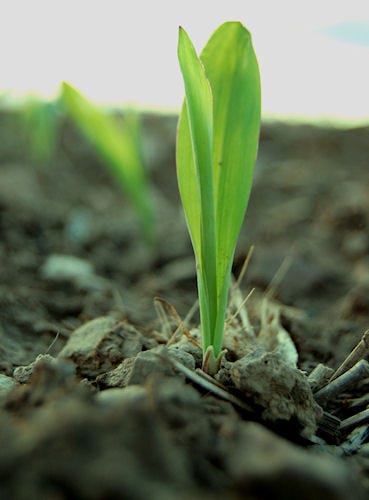May 10, 2011

This spring's corn planting delays already have corn growers thinking about switching to earlier maturing hybrids. That's why slow-to-spring springs drive local seed dealers crazy.
Planting full-season hybrids too late puts them at risk of cool weather and fall frost damage before maturity. But switching to earlier hybrids too soon can result in severe yield and profit penalties. In fact, the switching date may be quite a bit later than you think.
Here's a quick summary of extensive research over multiple years, as reported by Pioneer Research Agronomists Mark Jeschke and Steve Paszkiewicz. Draw your own conclusions based on comparable latitude and growing season length.

LET THE SEASON BEGIN! Farmers breathe a sigh of relief only after even populations of corn sprout up.
Central Corn Belt latitudes
The Central Corn Belt studies included environments in Nebraska, Iowa, Illinois and Indiana. At this latitude April planting of full-season hybrids provided the greatest profitability.
Full-season hybrids provided the greatest profitability when planted up until May 27. Switching to a shorter-season corn before then most likely won't be beneficial and may result in reduced profitability.
At this latitude, there was no significant profit penalty for staying with a full- or mid-maturity hybrid, even with delayed planting. Reason: Even when planted late, these hybrids often outperform earlier maturing hybrids by adjusting their growth and development to reach maturity in a shortened growing season.
But the switch point from mid-maturity corn to short-season hybrids is different at this latitude. Pioneer's work suggests no switching unless planting is delayed until after June 9. Even so, the economic results of both maturity groups are nearly identical at this point.
North Central Corn Belt latitudes
In South Dakota, Minnesota, Iowa, Michigan and Ontario, full-season hybrids provide the greatest profitability until about May 28. Growers may consider switching to an early maturity hybrid after this point. If planting is delayed until June 1 or later, switching has a more significant return.
If you're planting mid-season hybrids, consider switching to an early maturity hybrid only if planting is delayed until after June 5. After June 11, the switch has a significant advantage.
Far-Northern latitudes
In North Dakota, Minnesota and Quebec, early May planting of full-season hybrids provided the greatest long-term profitability. Even at this latitude, they'll still provide the greatest profitability until at least May 26. After about June 3, a shorter season corn will be more profitable in most cases.
If you're planting mid-maturity hybrids, switching to an early-maturity hybrid shouldn't be considered until after May 27. Even so, the long-term studies didn't show a significant advantage to doing so.
You May Also Like




